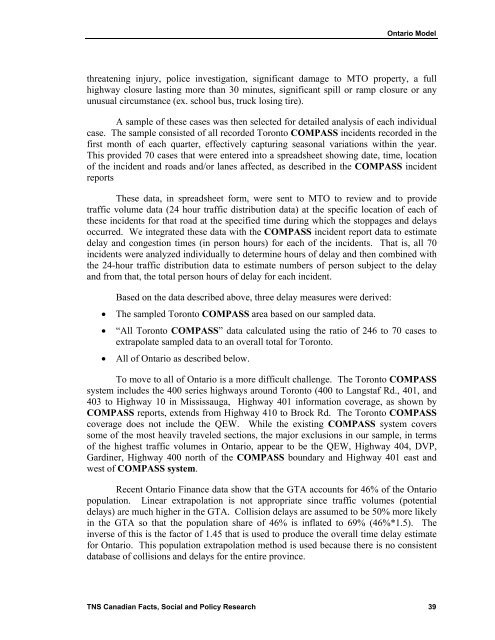Keith Vodden Dr. Douglas Smith - Transports Canada
Keith Vodden Dr. Douglas Smith - Transports Canada
Keith Vodden Dr. Douglas Smith - Transports Canada
You also want an ePaper? Increase the reach of your titles
YUMPU automatically turns print PDFs into web optimized ePapers that Google loves.
Ontario Model<br />
threatening injury, police investigation, significant damage to MTO property, a full<br />
highway closure lasting more than 30 minutes, significant spill or ramp closure or any<br />
unusual circumstance (ex. school bus, truck losing tire).<br />
A sample of these cases was then selected for detailed analysis of each individual<br />
case. The sample consisted of all recorded Toronto COMPASS incidents recorded in the<br />
first month of each quarter, effectively capturing seasonal variations within the year.<br />
This provided 70 cases that were entered into a spreadsheet showing date, time, location<br />
of the incident and roads and/or lanes affected, as described in the COMPASS incident<br />
reports<br />
These data, in spreadsheet form, were sent to MTO to review and to provide<br />
traffic volume data (24 hour traffic distribution data) at the specific location of each of<br />
these incidents for that road at the specified time during which the stoppages and delays<br />
occurred. We integrated these data with the COMPASS incident report data to estimate<br />
delay and congestion times (in person hours) for each of the incidents. That is, all 70<br />
incidents were analyzed individually to determine hours of delay and then combined with<br />
the 24-hour traffic distribution data to estimate numbers of person subject to the delay<br />
and from that, the total person hours of delay for each incident.<br />
Based on the data described above, three delay measures were derived:<br />
• The sampled Toronto COMPASS area based on our sampled data.<br />
• “All Toronto COMPASS” data calculated using the ratio of 246 to 70 cases to<br />
extrapolate sampled data to an overall total for Toronto.<br />
• All of Ontario as described below.<br />
To move to all of Ontario is a more difficult challenge. The Toronto COMPASS<br />
system includes the 400 series highways around Toronto (400 to Langstaf Rd., 401, and<br />
403 to Highway 10 in Mississauga, Highway 401 information coverage, as shown by<br />
COMPASS reports, extends from Highway 410 to Brock Rd. The Toronto COMPASS<br />
coverage does not include the QEW. While the existing COMPASS system covers<br />
some of the most heavily traveled sections, the major exclusions in our sample, in terms<br />
of the highest traffic volumes in Ontario, appear to be the QEW, Highway 404, DVP,<br />
Gardiner, Highway 400 north of the COMPASS boundary and Highway 401 east and<br />
west of COMPASS system.<br />
Recent Ontario Finance data show that the GTA accounts for 46% of the Ontario<br />
population. Linear extrapolation is not appropriate since traffic volumes (potential<br />
delays) are much higher in the GTA. Collision delays are assumed to be 50% more likely<br />
in the GTA so that the population share of 46% is inflated to 69% (46%*1.5). The<br />
inverse of this is the factor of 1.45 that is used to produce the overall time delay estimate<br />
for Ontario. This population extrapolation method is used because there is no consistent<br />
database of collisions and delays for the entire province.<br />
TNS Canadian Facts, Social and Policy Research 39
















